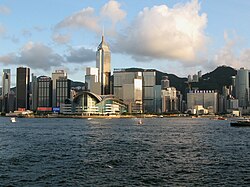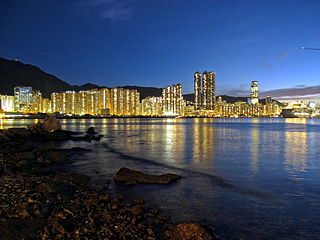
The Eastern District located on northeastern part of Hong Kong Island, being one of the 18 administrative districts of Hong Kong. It had a population of 529,603 in 2021 The district has the second highest population while its residents have the third highest median household income among the 18 districts.

Wan Chai District is one of the 18 districts of Hong Kong. Of the four on Hong Kong Island, it is north-central, and had 166,695 residents in 2021, an increase from 152,608 residents in 2011. The district has the second-highest educationally qualified residents with the highest-bracket incomes, the second-lowest population and the third-oldest quotient. It is a relatively affluent district, with one in five persons having liquid assets of more than HKD 1 million.
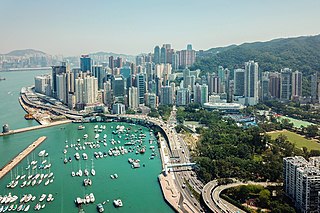
Causeway Bay is an area and a bay on Hong Kong Island, Hong Kong, straddling the border of the Eastern and the Wan Chai districts. It is a major shopping, leisure and cultural centre in Hong Kong, with a number of major shopping centres. The rents in the shopping areas of Causeway Bay were ranked as the world's most expensive for around a decade after overtaking New York City's Fifth Avenue in 2012. When referring to the area, the Cantonese name "Tung Lo Wan" is never written in English; "Causeway Bay" is always used.

Central, also known as Central District, is the central business district of Hong Kong. It is located in the northeastern corner of the Central and Western District, on the north shore of Hong Kong Island, across Victoria Harbour from Tsim Sha Tsui, the southernmost point of Kowloon Peninsula. The area was the heart of Victoria City, although that name is rarely used today.
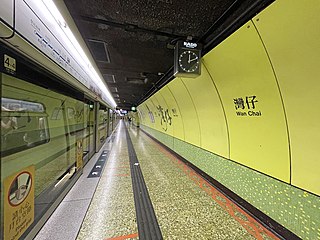
Wan Chai is a station on the Island line of the Hong Kong MTR rapid transit system. The livery colour is lime green. It serves the Wan Chai locality within the district of the same name. The station platforms are located underneath Hennessy Road, a major trunk road connecting the Central and Eastern districts.

The Hong Kong Convention and Exhibition Centre (HKCEC) is one of the two major convention and exhibition venues in Hong Kong, along with AsiaWorld–Expo. It is located in Wan Chai North, Hong Kong Island. Built along the Victoria Harbour, it is linked by covered walkways to nearby hotels and commercial buildings. The venue was designed by Skidmore, Owings & Merrill LLP, in association with Wong & Ouyang (HK) Ltd. Larry Oltmanns led the design as the Design Partner with SOM.
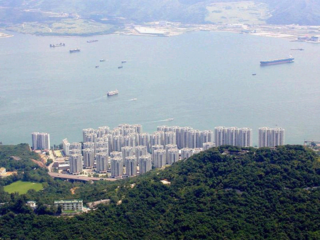
Heng Fa Chuen is a private housing estate in Chai Wan, Hong Kong Island, Hong Kong, jointly developed by MTR Corporation and Heng Fa Chuen Development. It is located on the waterfront and offers views of the Tathong Channel. Heng Fa Chuen lies within the Eastern District.

The Wan Chai Pier, or Wan Chai Ferry Pier, is a pier at the coast of Wan Chai North on the Hong Kong Island of Hong Kong. The pier is operated by Star Ferry, and provides ferry services to Tsim Sha Tsui. The pier is near the Hong Kong Convention and Exhibition Centre.

Gloucester Road is a major highway in Hong Kong. It is one of the few major roads in Hong Kong with service roads. It was named on 14 June 1929 after Prince Henry, Duke of Gloucester, to commemorate his visit to Hong Kong that year. The road is 2.2 kilometres in length and has a speed limit of 70 km/h.

Queen's Road is a collection of roads along the northern coast of Hong Kong Island, in Hong Kong, within the limit of Victoria City. It was the first road in Hong Kong, constructed by the British between 1841 and 1843, spanning across Victoria City from Shek Tong Tsui to Wan Chai.

Southorn Playground is a sports and recreational ground in Wan Chai, Hong Kong. It comprises a football pitch, four basketball courts, and a children's playground.

Wan Chai Sports Ground is a stadium in Wan Chai North, Hong Kong Island, Hong Kong, with a seating capacity of 2,401. It is a government-run sports ground primarily used by local schools for sports days and other athletic activities. Situated by the Victoria Harbour, it is at a convenient location next to Hong Kong's Central business district, Wan Chai, and the shopping district of Causeway Bay.
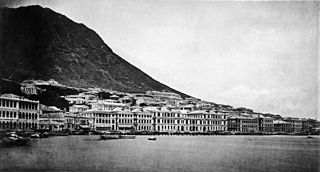
Praya was a term used in 19th-century Hong Kong to refer to a promenade by the waterfront. The name comes from the Portuguese word praia, which means "beach," but in China it came to mean a stone-faced waterfront road. In Hong Kong, it was a broad road running parallel along the harbour in front of the city. HSBC and Dent & Co. were just some of the major companies based in the area.

Star Ferry Pier, Central may refer to any of the successive generations of Central Ferry Piers in Central, Hong Kong used by the Star Ferry for its services across Victoria Harbour to Tsim Sha Tsui Ferry Pier and until April 2011, to Hung Hom Pier. The current Star Ferry pier is the fourth to bear the name in Central. It opened for public service on 12 November 2006.

Tonnochy Road is a street in Wan Chai on the Hong Kong Island of Hong Kong. It runs from Hennessy Road, across Lockhart Road, Jaffe Road, Gloucester Road, to Hung Hing Road near Victoria Harbour. The wide Gloucester Road divides Tonnochy Road into a north and a south sections. Gloucester Road has a flyover to turn into the road at the north.
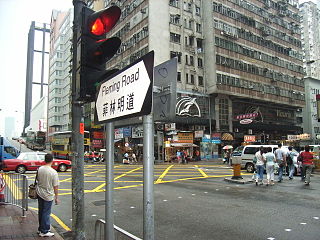
Fleming Road is a road in Wan Chai and Wan Chai North on the Hong Kong Island of Hong Kong. The road begins south with Johnston Road, runs across Hennessy Road, Lockhart Road and Jaffe Road, flies over Gloucester Road and runs across Harbour Road and ends at the junction with Convention Avenue and Expo Drive East.

Central and Wan Chai Reclamation is a project launched by the government of Hong Kong since the 1990s to reclaim land for different purposes. This includes transportation improvements such as the Hong Kong MTR station, Airport Express Railway & Central-Wan Chai Bypass, as well as public recreation space such as the Central Harbourfront Event Space, Tamar Park and the Hong Kong Observation Wheel.

Causeway Bay Typhoon Shelter is a typhoon shelter located in Causeway Bay, Hong Kong, between the Hong Kong Island entrance of Cross-Harbour Tunnel on Kellett Island and Island Eastern Corridor. It was the first typhoon shelter in Hong Kong. It is roughly 17 hectares in area.

Wanchai Tower is an office building in Wan Chai, Hong Kong. Located at 12 Harbour Road, it is home to the District Court and government offices. Neighbouring buildings include Immigration Tower, Revenue Tower and Shui On Centre.

Immigration Tower is a skyscraper located in the Wan Chai District of Hong Kong completed in 1990. The tower rises 49 floors and 181 metres (594 ft) in height. Immigration Tower, which stands as the 93rd-tallest building in Hong Kong, is composed entirely of office space. The building houses government offices, principally those of the Immigration Department.
